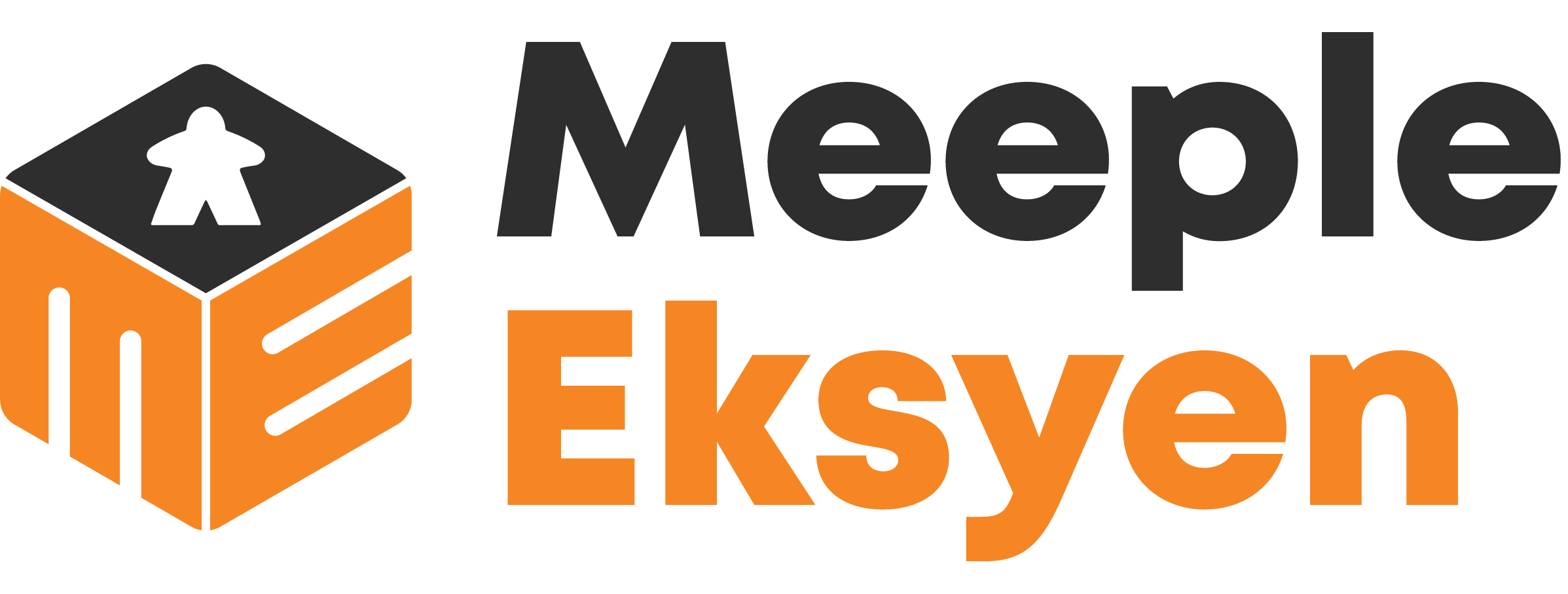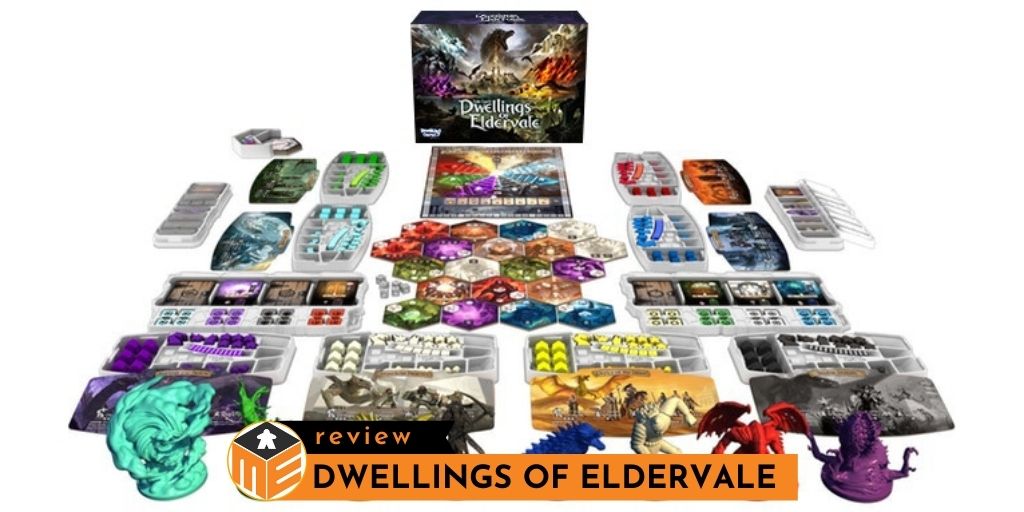Dwellings of Eldervale was a successful Kickstarter project released by Breaking Games in 2019. I’ve been a fan of its designer, Luke Laurie, the man behind The Manhattan Project: Energy Empire. My first perception of Eldervale was a fantasy game with monsters, minis, and battles using a similar mixture of mechanisms. I was intrigued and, thus, backing the game with high expectations.
For disclaimer purposes, my entire review here is based on my experience with the Legendary Edition. Hence, it may be different in comparison to the retail version.
FIRST, LET’S START WITH THE PRESENCE AND COMPONENTS
Upon opening the humongous Legendary box, immediately I noticed the two big trays. They store in total 16 monster miniatures. There are more trays below and a bunch of other components. The meeples are shaped accordingly, for example workers, warriors, and dragons. We did observe some other resource components, too.
With the enormous amounts of components, Dwellings of Eldervale also comes with separate faction trays. Repacking all components to the corresponding trays took me a good two hours. When it was done, it was satisfying as hell.
Not only it made me feel good, these pre-setup also cuts down the setup time a lot. Whenever we need to play this game, we just have to distribute the trays and begin playing.
I have played Dwellings of Eldervale several times, and I must say I am hooked thanks to its great components. The wooden components and the boards look gorgeous with their clear and vibrant colours. The tiles are thick and colourful, with clear iconography that helps to understand the game thoroughly. The minis are actually a-okay, and they are washed.
PLAYING THE GAME
The game is relatively simple despite the 3.2 complexity rating on Board Game Geek. Six out of the eight elements represented by the factions in Dwellings of Eldervale will present in each game: air, earth, fire, water, light, darkness, order, and chaos.
Replay value and variable player power portion of the game
The absent elements’ adventure cards and tiles will be inaccessible during that gameplay. This implementation contributes to the replay value on-the-go.
In each turn, players play either one of the primary actions to place units in the realm of Eldervale and reap the tile’s benefit, or simply regroup. The units consist of workers, warriors, wizards, and dragons. The workers are readily available to build, while the other three are open for recruitment.
Dwellings of Eldervale blesses two out of the four units on each faction with different powers. This brings forth the variable player powers into the game.
Of course, with such things present on the table, it increases the replay value, too.
The high variability means we can play different faction combinations. Each faction is unique and distinct enough to drive different playing styles. For example, it would be nonsense to play a swarming ‘Embercrush Ogres’ because this faction focuses on raw power. Furthermore, I didn’t notice any imbalance in each faction that may create any meta in Dwellings of Eldervale.
Deploying and regrouping units are crucial
The rules that govern how to place the units are actually straightforward. We could bypass these by using some powers mentioned before. And it’s interesting to see when any units from different factions meet on the same tile: the battle begins. Monsters rushing to an adjacent units also trigger this event.
Deploying units becomes the main gist of the game. Through this action, players can reap the tiles’ benefits, collect resources, gather Adventure cards, and build their tableaus, as well as their dwellings on the board.

After deploying all their ready units, players can go to the next primary action, the regrouping. Having a similar regrouping mechanic like in The Manhattan Project: Energy Empire (and maybe also utilized in any other games), the regroup action is good for collecting units from their deployment. They will be ready for the upcoming turns. What’s nice in Dwellings of Eldervale is what comes next after the regrouping.
When regrouping, players may still employ the units to activate their tableau. This mechanic provides an interesting combination in Dwellings of Eldervale. To give some depth to the game, only the units which survive the realms can interact with the tableau.
Battling in the realm
The battle mechanic in Dwellings of Eldervale is relatively simple. Players may deploy reinforcement from the adjacent tiles before evaluating power and counting the dice to roll. Additionally, all parties may also spend resources to add more dice and play some magic cards.
After casting the dice, we compare the number of dice from the highest pips. If it’s a draw, then compare again, gradually to the lower pips, until the tie breaks. The winning party keeps their unit, moves up on the glory track, and gains the benefit. Meanwhile, the losing units will move on to the underworld. They gain some resources to be utilized on the next turn for each worker deployed.
Yes, the battle in Dwellings of Eldervale uses dice, and that means luck plays an important role. Nevertheless, losing a battle does not become a showstopper. Even before the battle begins, we can still reap the tile benefit, and when we lose, the game still grants us resources for the following turns.

In some cases, I witnessed some players intentionally lost the battle, letting their units got killed. It was a smart move to place some other workers on the further tiles. That would have been impossible if they still had some workers because players can only place workers adjacent to the ones on the board.
A Quest card also requires the players to lose the battle, and it leads to gaining Victory Points. This depicts the phrase, “You lose the battle to win the war.” Losing the conflict can be a setback, but it may actually open some new other opportunities to gain more points.
Balancing the element tracks
Another important part is how players balance the progression on element tracks. Out of the number of elements in-play, players can only associate themselves with at most four of them. Each of them has its track, it provides higher Victory points for their cards, and dwellings if they are higher on the track.
Completing all tracks may sound profitable, but it is nearly impossible. Hence, players need to balance their strategy with the element tracks they want to pursue.
Some minor downsides
There are some cons, but they are merely cosmetic and component-wise. My Legendary pledge comes with a sound base that generates nice sound effects when the monsters are moving on the board. It is a nice touch, but they are really tight. I was afraid it will rip when I put it on and take it off.
Post-playing the game, I realized this sound base is a necessary way to be a marker. It shows which player dominates that particular monster. However, feel free to not use it because it would not really downgrade your gaming experience.
Additionally, the faction boards act as the cover for each player tray. However, they don’t really fit and too constricted. I have seen some chaffing on my player board due to the frictions.
FINAL REMARKS
The Dwellings of Eldervale has exceeded my expectation. It combines worker placement, tableau building, set- and resource-collection, and area control. There are multiple mechanics, which might not be that deep. But thanks to the combination with the other parts, this becomes my most enjoyable game in 2020. It would be an interesting game if they add negotiations, though. I am looking forward to playing the other factions and other element combination.







